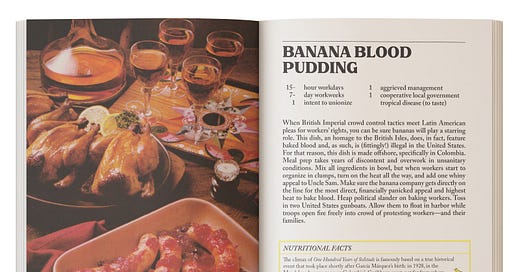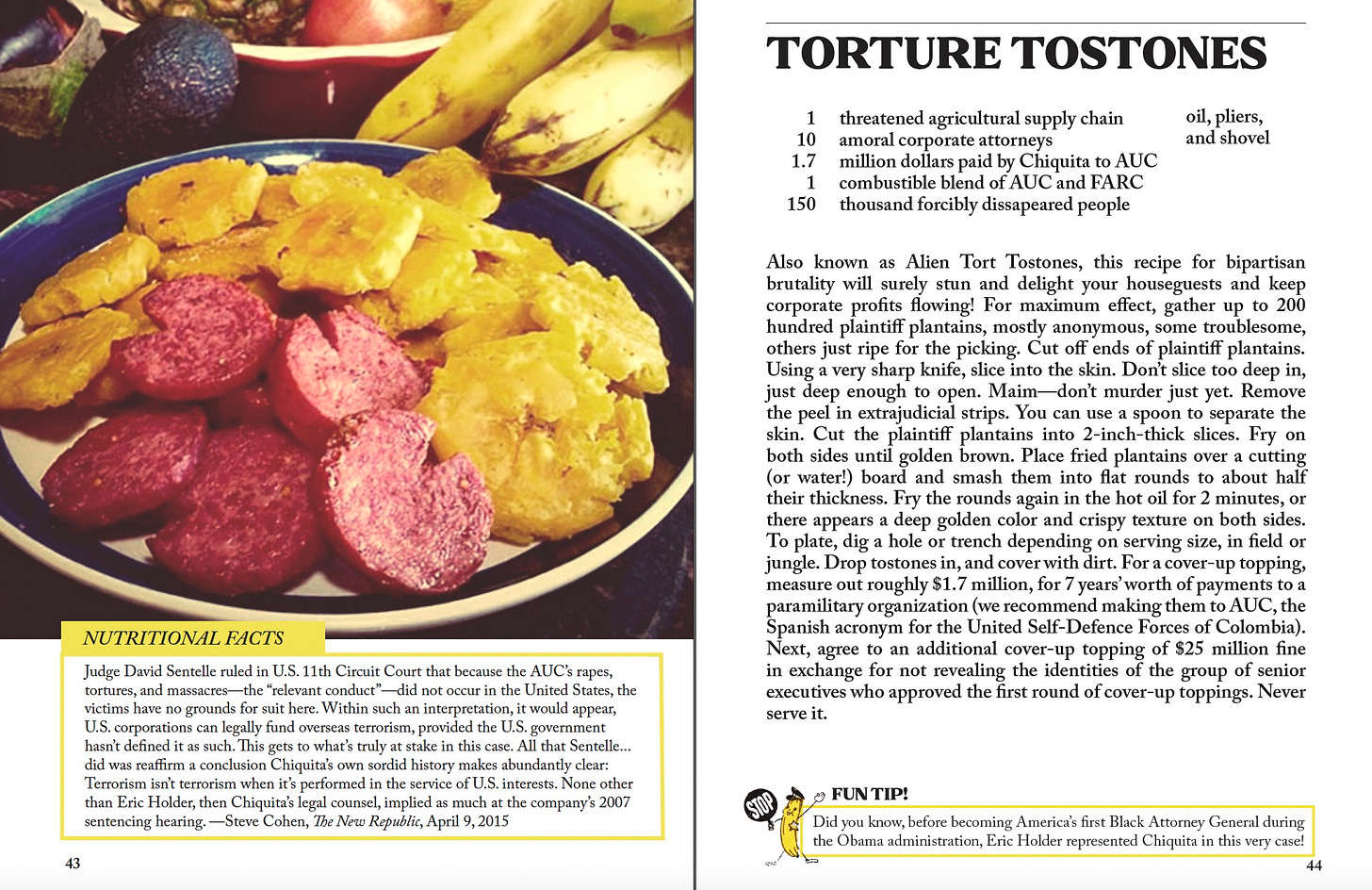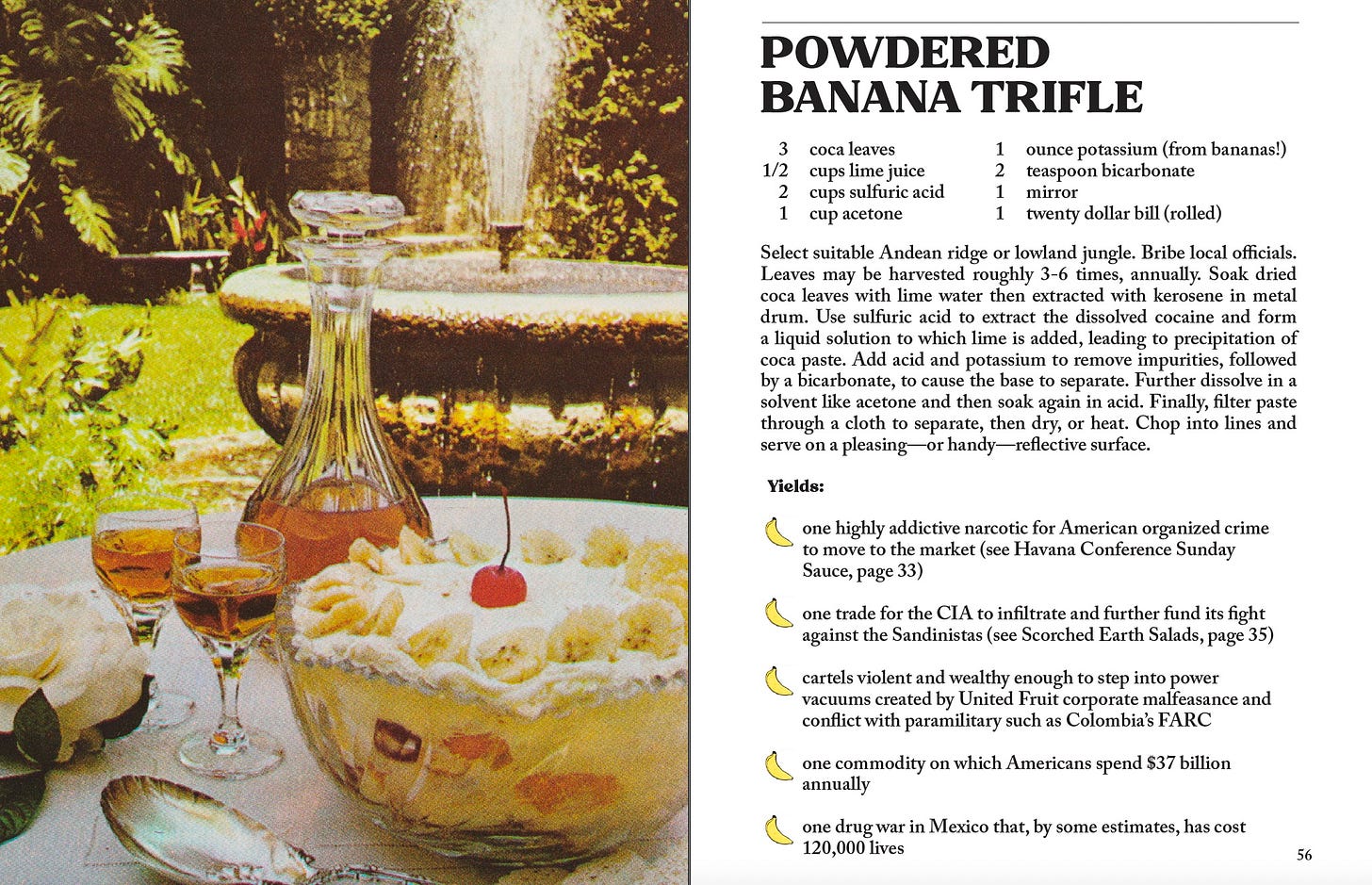Big week over here! Johannah and I are presently flat-packing our ¡AGITPOP! show to go on the road to the Paris Ass Book Fair at the Palais de Tokyo and our lecture-performance at the museum on Sunday, May 18 at 5pm. Additionally, Frieze NY opens Wednesday at Hudson Yards, where Printed Matter will bring all five of our titles, along with the newly restocked Spanish-language translation of the book I’m excerpting today, The Banana Republication Recipe Book—or, if you prefer, Recetas de las Repúblicas Bananeras.
Equal parts propaganda and home economics, The Banana Republican Recipe Book is a dark riff on the United Fruit company’s recipe booklets of the mid-20th century. Now known as Chiquita Brands, United Fruits was anything but a cheery purveyor of tropical produce. Rather, the corporation worked hand-in-glove with the US Government and the CIA to facilitate regime change, crush labor organization, defeat environmental advocacy, grab indigenous land, and, above all, ensure that the banana stayed unreasonably cheap—and astronomically profitable—in supermarkets across the world. The Banana Republican Recipe Book is a fresh take on the rotten underbelly of America’s favorite fruit.
By adopting the format of a Chiquita brands recipe book, Johannah and I retell an incredibly dark story of a shadow-empire in as cheery and delusional a tone as it was advertised to American consumers coast to coast. The introduction, included below, adopts the tone of such a target audience, specifically a housewife hopped up on mother’s little helpers, but set in the year we published the book, 2021. The recipes themselves tell histories in the format of various imagined dishes. For example, “Banana Blood Pudding” is a retelling of the banana massacre, the pivotal traumatic event of One Hundred Years of Solitude. In fact, the only actual recipe we included is how to refine cocaine, and I’ve included that below, too, for the hell of it, as well as some other pages scattered throughout.
“Look at the mess we've got ourselves into, just because we invited a gringo to eat some bananas.”
―Gabriel García Márquez, Cien años de soledad
A note from the CIA — the other CIA, silly!
(The Culinary Institute of America in no way endorses this book.)
Housewife is such a dated term. But, hey, those dishes aren’t about to clean themselves! The home has taken on an outsized importance in this past year. And, within it, it seems the chores are never done—and no one ever leaves. The theater of domesticity demands pandemic peak performance and that kitchen, you better believe it, is the main stage. Why, some days it seems we are sliding right back into the 1950s; American economists estimate women have been pushed back 25 years in terms of gender parity—that’s a quarter century! Wow! No wonder that for the past 14 months food has been our only source of joy.
Now, as you frantically shed those pesky pandemic pounds—what with America open for business and your husband free to roam—you need a slimming snack. Moreover, you need one that is both low in calories and so simple to prepare, it comes in its own handy, little jacket, waiting to yield to your ravenous post-pandemic mouth.
Ladies, look no further: the Cavendish banana (Musa acuminata Cavendish) is here to help! Why Cavendish? Well, really there is just one kind of banana out there that won’t cost you an arm and a leg. Choice, you see, can be overwhelming; diversity, confusing. Can you name all the apples out there? I sure can’t! All those varietals of local apples from local farms—who can even keep them straight? Citrus isn’t here all year. And grapes—who needs them before they’re white wine for the book club?
The banana boasts many charms, but we forget Mr. Cavendish is one versatile fella. We want to show you all the ways to enjoy him in this handy new recipe book! He can help you both slim down and entertain. A single banana can provide up to 15% of your recommended potassium intake, helping to lower blood pressure and improve heart health. That same medium-sized banana can provide up to one third of the recommended daily intake of vitamin B6, and is a great source of vitamin C.
America’s love affair with the banana is now nearly 145 years old, beginning at the World’s Fair in Philadelphia on June 5, 1876. The yella fella stole the show! Truthfully, the Cavendish wasn’t anyone’s first choice. American corporatized farming interests first fell hard for the Gros Michel banana—or “Big Mike.” That is, until Panama disease, a wilt caused by a virulent fungus, devastated the entire cultivar in the 1950s.
This blight struck, of course, at the peak of Cold War tensions, forcing the entire American banana operation to scramble for a new cultivar that could satisfy the economy of scale built up around “Big Mike,” as well as keep the banana’s Central American dictatorial friends happy and—you know—in office. But, hey, any silly goose knows it’s only a free and fair election when Uncle Sam counts those votes!
So, the industry arrived at the Cavendish, a banana with thick skin that ships well, spoils slowly, and will grow basically anywhere tropical if larded up with enough pesticide to keep the local flora and fauna at bay. Easy peasy! That’s monoculture for you! One crop, one item that always fits the bill with a short growing cycle to keep the shelves stocked and the prices down. Way down. In fact, so down, that the American plantations which populate vast swaths of Latin American land have hardly any incentives to diversify crops, or consider the environmental toll of their undertaking—to say nothing of the workers’ lives, or the sordid political machinations that keep it all going.
One might contend that, in the Western Hemisphere, monoculture is one handy metaphor for our not-so-subtle brand of American empire. But we don’t need to worry your hangry little head about it here. Think about Cavendish this way: we want something exotic, but consistent too! We want a food that simply arrives from 3,000 miles away and is inexplicably the sixth of a price of an apple from a neighboring county. Indeed what could a banana cost?
Monoculture, really, enables the monovision you need to get from one day to the next. Don’t think beyond it! Focus on that bright supple fruit on your counter and don’t worry about how it got there. It’s been a year of tough news and trying headlines. It seemed we couldn’t keep world events away even trapped at home. Now that’s over! After all, at the tail end a year in (sporadic) lockdown, it’s not blood that’s on your hands—just time to learn a few new recipes before it’s all over! This spring, think outside of 2020’s banana bread box, and expand your culinary horizons to a brave, reopened economy!
Bananas supply nutrition for a return to normalcy—whatever that means in your own imagined version of reality! What’s more miraculous than a banana that simply arrives from Ecuador or Guatemala—countries separated by over 2,100 miles—and is always exactly the same and obscenely inexpensive? Cheap and uniform nutrition! Will wonders never cease?
America is the land of the free, the home of the brave, and it knows darn well that happy hearth is a hegemonic one. The only diversity we care about is in our stock portfolio! That’s why we support a monoculture. Consistency, after all, is the American hallmark of a freakishly over-controlled, hydroponic, regional political climate. Who needs more than one kind of exotic? We just need one: not “us,” but digestible, consistent, and predictable—like a Club Med vacation or Carnival Cruiseliner in your mouth!
Mr. Cavendish knows best! In fact, the Latin name for the banana translates as wise fruit, so trust your potassium levels to this tasty feller and never tire again as you vacuum for your demanding (but loving!) husband. Who knows? You might spend so much time together with Mr. Cavendish, that husband of yours might grow a little green with banana envy! But, ladies, isn’t that what keeps them coming back for more?
We invite you to make your kitchen a glorious banana republic of low-calorie, easy-prep treats! Bring the plantation home right where it belongs: on your kitchen counter.









